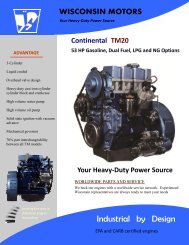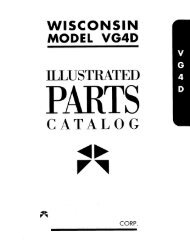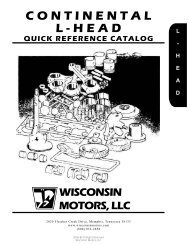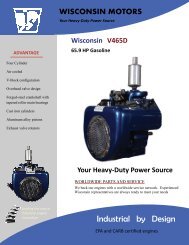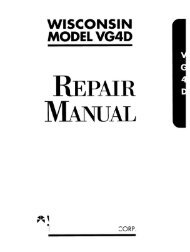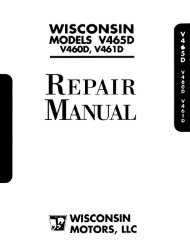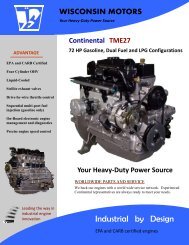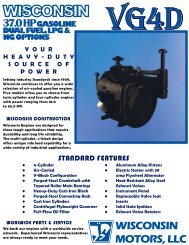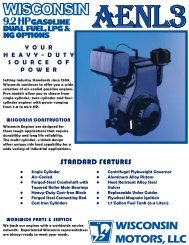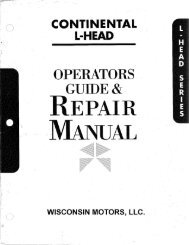REPAIR MANUAL - Wisconsin Motors
REPAIR MANUAL - Wisconsin Motors
REPAIR MANUAL - Wisconsin Motors
- No tags were found...
Create successful ePaper yourself
Turn your PDF publications into a flip-book with our unique Google optimized e-Paper software.
Section 8 - Engine Repair and Overhaul<br />
This section includes instructions for repairs<br />
and overhaul of the component units of Continental<br />
industrial diesel engines.<br />
4. Disconnect the injectors and leak-off lines at<br />
both the nozzle and pump connections.<br />
Provide a clean place to work and clean the<br />
engine exterior before you start disassembling--<br />
dirt causes engine failures.<br />
Many shop tools have been developed to save<br />
time and assure good workmanship; these should<br />
be included in your equipment.<br />
Use only genuine Continental parts in Continental<br />
engines since years of development and<br />
testing have gone into these specifications to<br />
assure maximum life and performance.<br />
CYLINDER HEAD<br />
Socket relief<br />
clearance<br />
The cylinder head is the most important part of<br />
the engine assembly since it contains the complete<br />
combustion chamber including valves, fuel<br />
injection nozzles, glow plugs, and cored passages<br />
for air, exhaust and water flow.<br />
REMOVING THE CYLINDER HEAD<br />
1. Drain water from engine and disconnect<br />
radiator or heat exchanger hoses.<br />
Caution should be used when replacing the fuel<br />
injectors to prevent loosening the injector leak-off<br />
nipples.<br />
2. Remove cylinder head cover by removing the<br />
capscrews holding the cover to the cylinder head.<br />
3. Remove rocker arm shaft assembly and push<br />
rods. Grip the push rods and snap them sideways<br />
out of the tappet sockets as shown in the illustration.<br />
This method serves to break the hydraulic<br />
connection and permits lifting the push rods out<br />
and leaving the tappets in place.<br />
Disconnecting Injector<br />
Leak-off Line<br />
caps<br />
pre-<br />
CAUTION: Always cover openings with protective<br />
at any time when lines are disconnected. This will<br />
vent any dirt or foreign matter from entering.<br />
Be sure to cut a relief in the inside of your<br />
socket for clearance. This will prevent an interference<br />
between the socket and the leak-off<br />
nipple.<br />
Removing Push Rod from Ball Socket of Tappet<br />
5. Remove injection nozzle assemblies. Place a<br />
protective cap over ends of injector for keeping<br />
openings clean. Refer to fuel injection system for<br />
testing procedures, page 24.<br />
39



